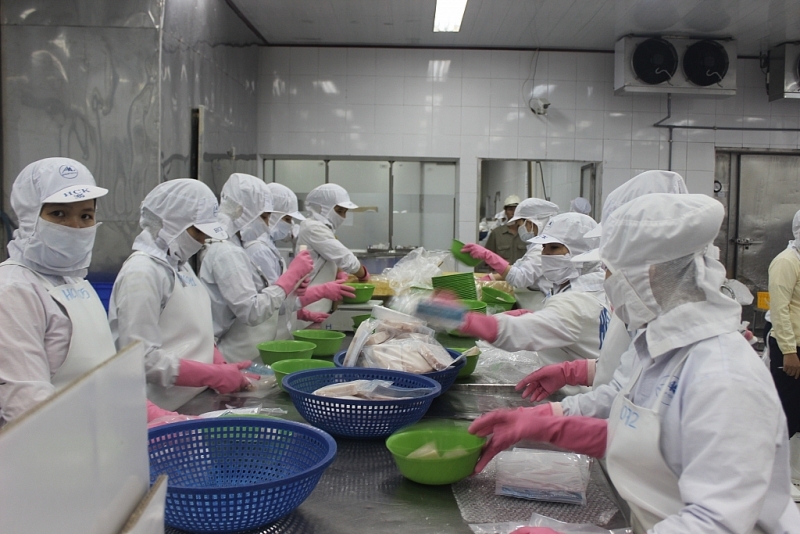 |
| Seafood enterprises commit to only buy aquatic raw materials from fishing vessels that have sufficient certificates of food safety facilities. Photo: T.H |
Comply to remove yellow card
The European Commission (EC) has agreed to extend the “yellow card” warning period for Vietnam’s seafood industry until the end of April 2024. However, to pass the 5th inspection, Vietnam put an end to the situation of illegal fishing vessels and fishermen in foreign waters; Control, confirm, certify and trace the origin of exploited aquatic products according to regulations…
In order to improve the effectiveness and efficiency of implementing legal regulations in state management, especially at the initial production stage in the production and processing chain of aquatic products for domestic consumption and export, businesses Seafood export processing industry commits to “say no to IUU”; Only buy aquatic raw materials from fishing vessels that have a sufficient Food Safety Facility Certificate (Food Safety) and food safety commitment to ensure compliance with food safety laws and combat IUU fishing.
At the same time, seriously implement Circular 17/2021/TT-BNNPTNT of the Ministry of Agriculture and Rural Development (MARD) on traceability and recall and handling of products that do not ensure food safety, including regulations Determine: establishments must establish a food traceability system according to the principle of one-step-first, one-step-later traceability to ensure the ability to identify and trace a product unit at specified stages of the process of food production and business;
When there is a request to trace the origin of food, the establishment must provide stored information about the establishment providing the received shipment and the establishment receiving the delivered shipment during the establishment’s production and business process.
Maintain full records of raw material suppliers for businesses, including records proving that exploited seafood does not violate IUU and food safety regulations in accordance with current regulations. Review the enterprise’s quality management and internal control processes on food safety and anti-IUU exploitation and ensure the organization properly implements the issued procedures.
Recommendations to remove problems related to exploitation
In addition to complying with regulations, seafood businesses propose to authorities to remove obstacles in the exploitation and use of raw materials for seafood export.
According to the Vietnam Association of Seafood Exporters and Producers (VASEP), by the first quarter of 2024, many fishing vessels in provinces and cities lack food safety certificates (certification for vessels over 15m, and commitments for vessels under 15m) according to the provisions of Circular 38/2018/TT-BNNPTNN and Circular 17/2018//TT-BNNPTNN of the Ministry of Agriculture and Rural Development. Some fishing ports also do not have or are slow to implement food safety certification.
The current situation and shortcomings mentioned above have caused many seafood shipments purchased by businesses in recent times to be ineligible to receive, appraise and issue H/C certificates for export to the EU, causing many difficulties for businesses. All raw materials that businesses purchase from ships that lack commitment, lack food safety certification, and ports that lack food safety certification before Decision No. 5523/QD-BNN-CCPT takes effect, currently cannot be exported to the EU due to not eligible to be issued an H/C certificate for the shipment.
The above reality leads to businesses not being able to deliver goods to partners on schedule, goods being left behind, generating a lot of costs and difficulties for businesses. This situation and situation will have a negative impact on seafood exports to the EU when the source of exploited seafood is significantly narrowed.
The above problems are being considered by the Ministry of Agriculture and Rural Development with instructions to resolve them; Direct provinces to properly and fully implement regulations on appraisal and certification of food safety conditions for fishing vessels, fishing ports, fish markets…; Consider issuing H/C for shipments that have been issued Certificate of Exploited Raw Materials (S/C) that encounter the above inadequacies.
In addition, according to businesses, the content of the exploitation certificate (C/C) exported to Japan currently has more requirements than Japan’s requirements for small fishing vessels (under 12m).
Specifically, Official Dispatch No. 1562/QLCL-CL1 dated November 16, 2022 of the Department of Agriculture, Forestry and Fisheries Quality Management, guiding the declaration of exploited aquatic products for export to the Japanese market. Accordingly, C/C papers for shipments exported to Japan apply according to the C/C form in Circular 21/2018/TT-BNNPTNT and amended in Circular 01/2022/TT-BNNPTNT dated January 18. /2022 of the Ministry of Agriculture and Rural Development. However, according to Japanese regulations, the C/C form for export shipments to Japan does not require declaring the following information for small ships that do not need to be located: exploitation area, exploitation time. While the C/C form according to Circular 21 mentioned above still has regulations on declaring this information.
From the above reality, businesses recommend that the Ministry of Agriculture and Rural Development consider and appropriately adjust C/C paper regulations for the Japanese market according to Japanese regulations for small fishing vessels (under 12m).
